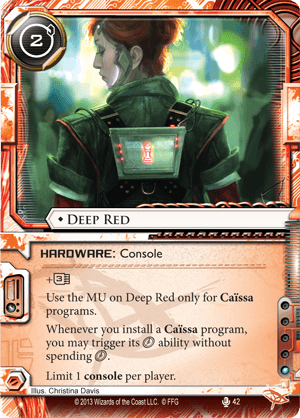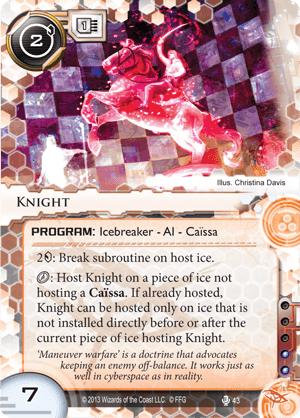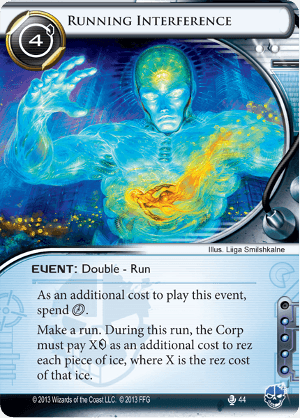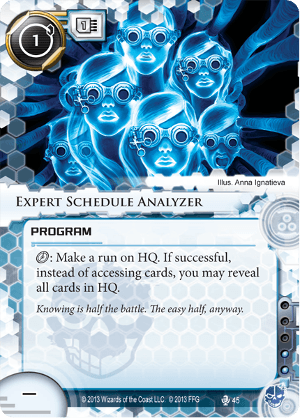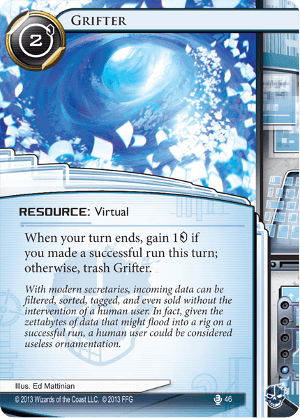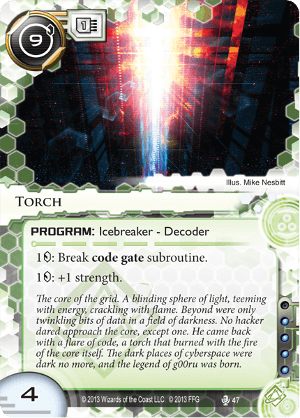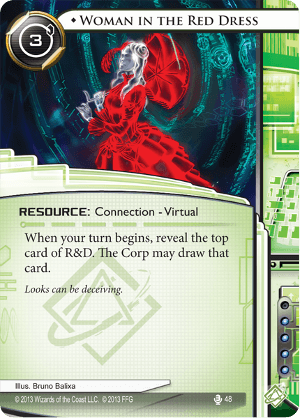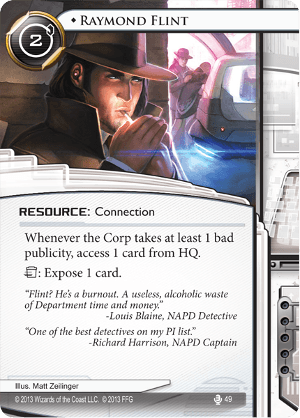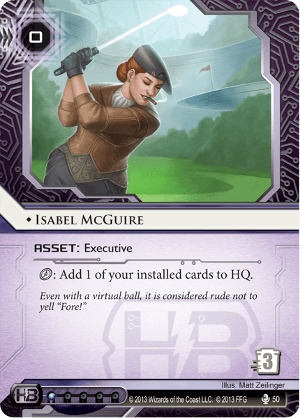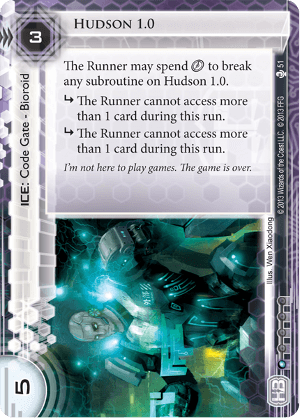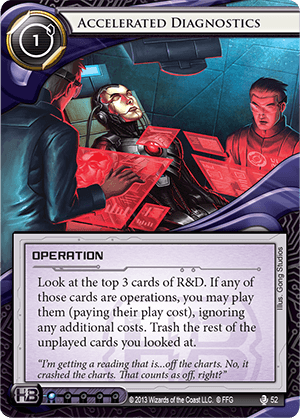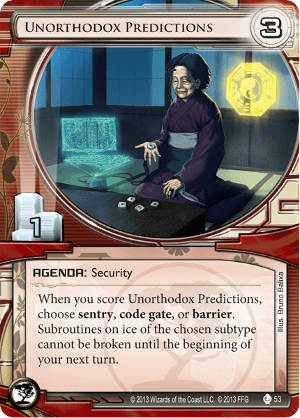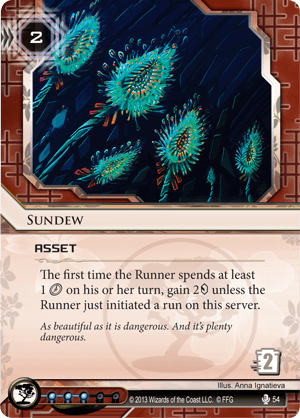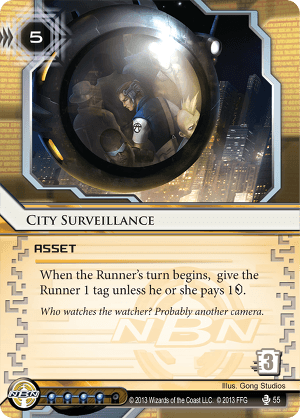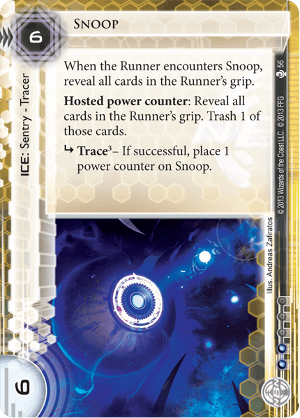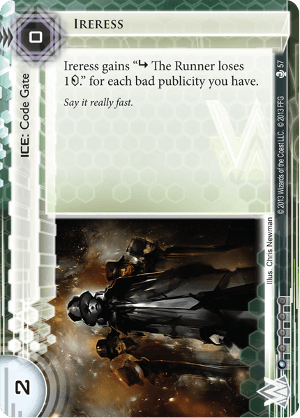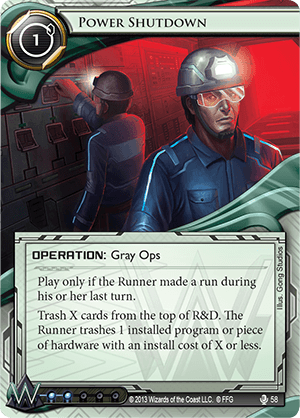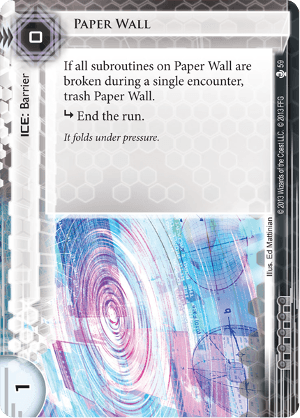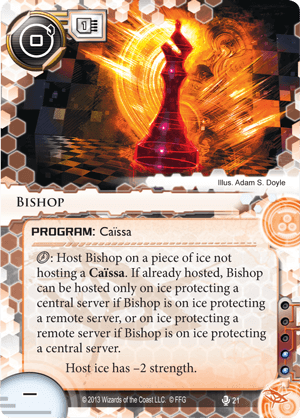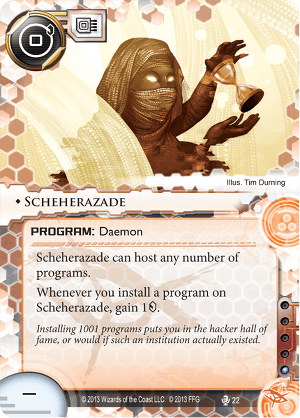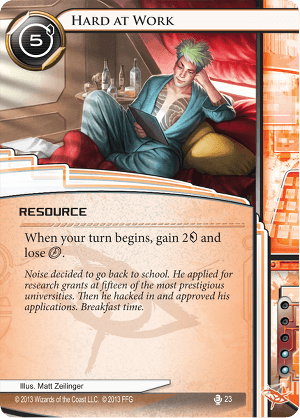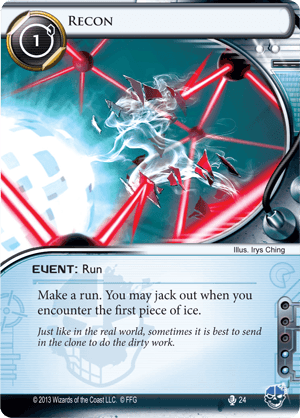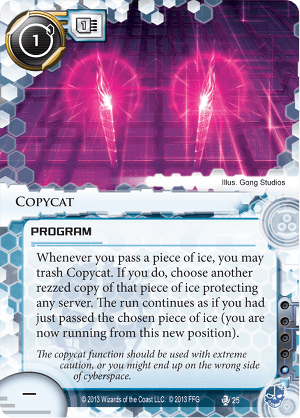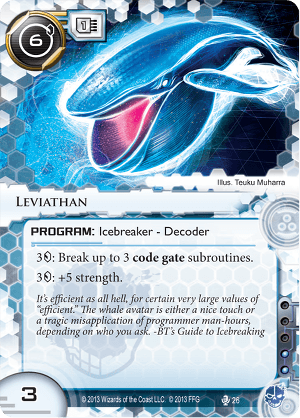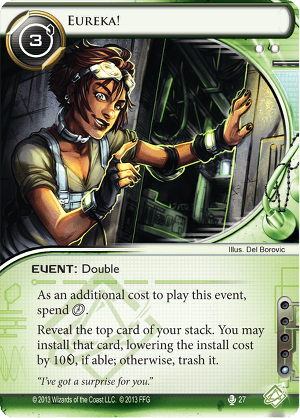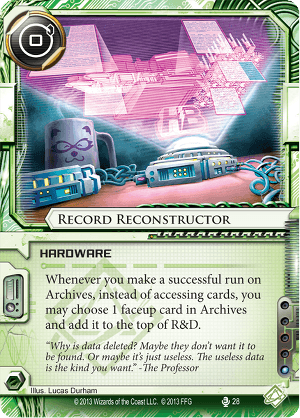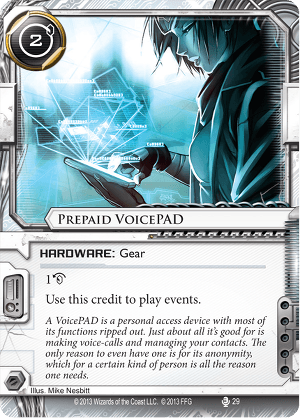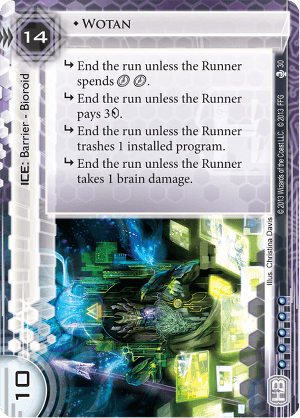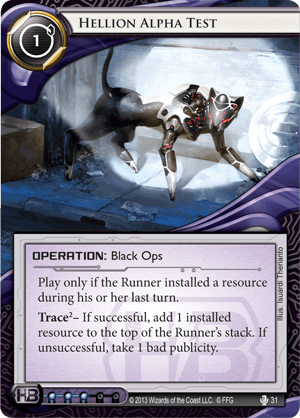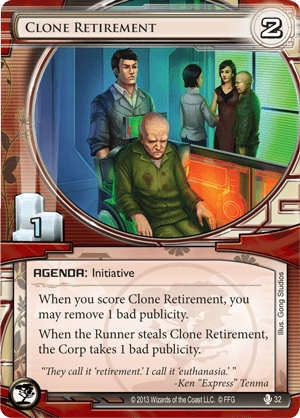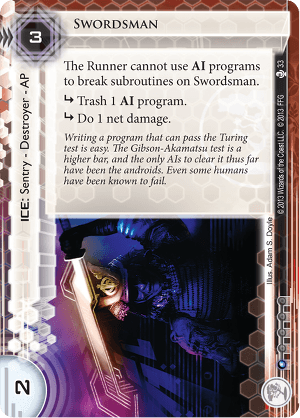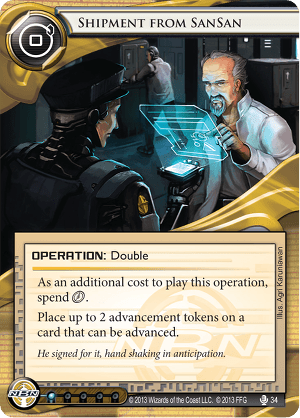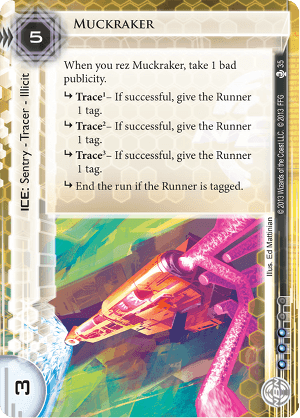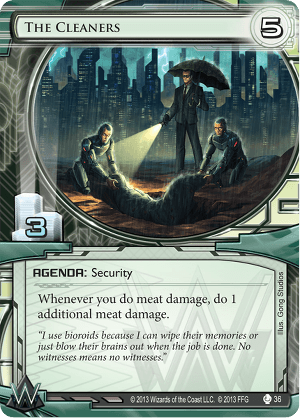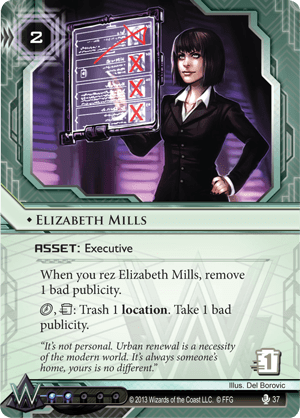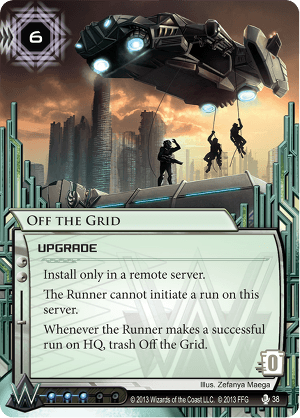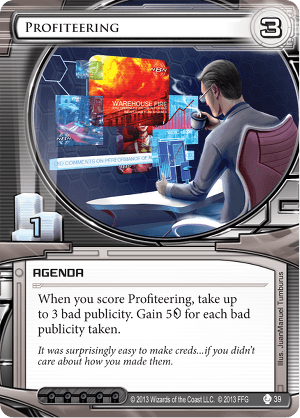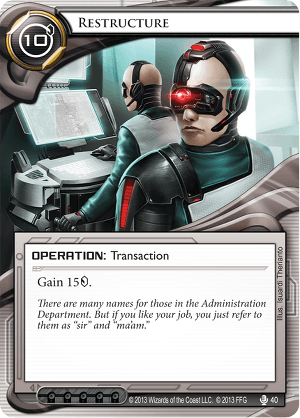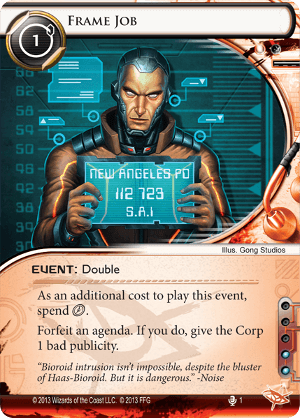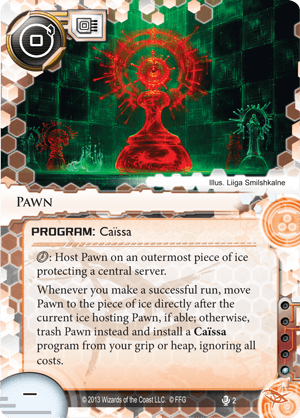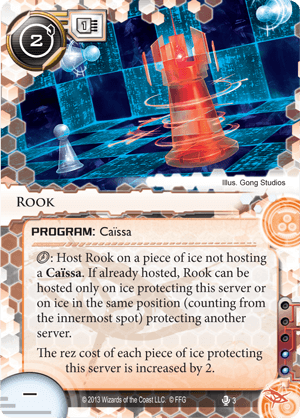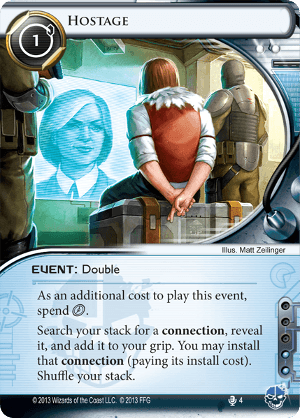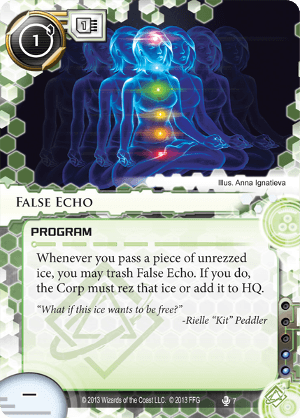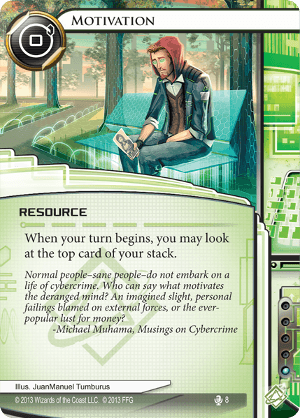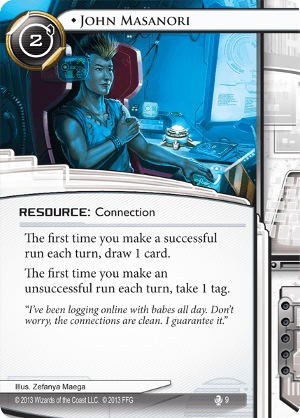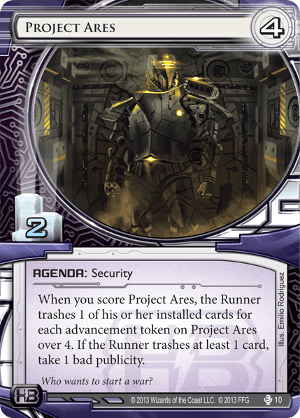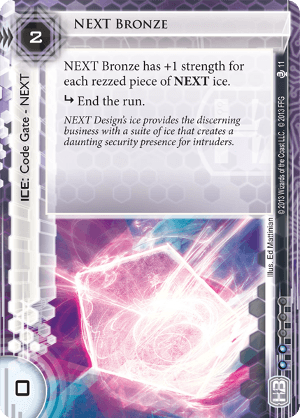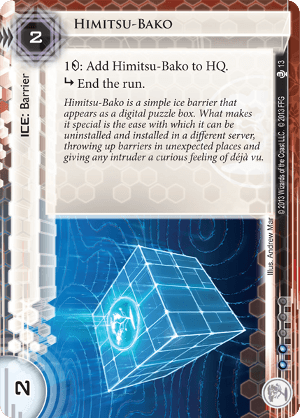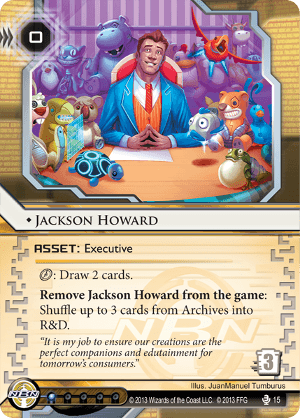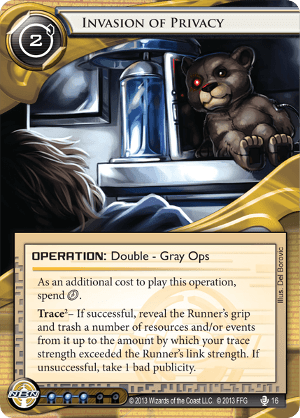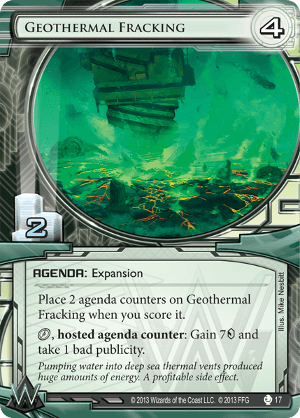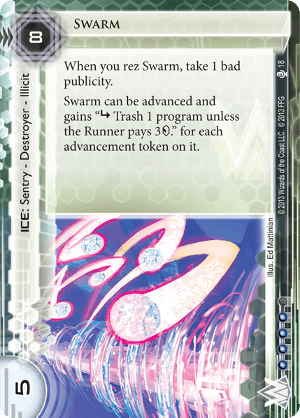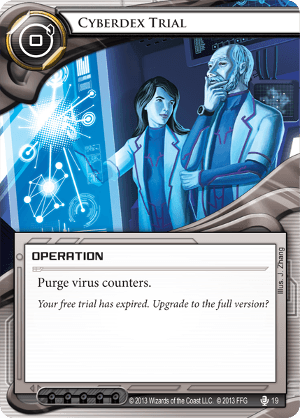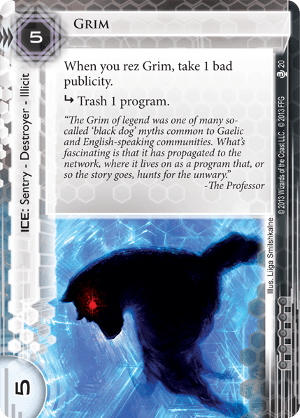For Mala Tempora, the insert is a Weyland file on known cyber-terrorist Reina Roja. The summary at the bottom marks her as being the prime suspect in the Phillips case. So now we have a who, and potentially a how, although the why is not completely clear yet. For now, we will have to dig a bit deeper as we look into the cards from this pack.
Reina Roja: Freedom Fighter
The first (and only) runner identity of this cycle is the aforementioned Reina Roja, or Red Queen. Interestingly, she has both the cyborg and g-mod subtypes on her identity, although we have yet to see any cards that relate to identity subtypes. At any rate, she has the standard 45 card minimum deck size and 15 influence, plus she starts with a base link strength of 1. But her ability is intriguing. She increases the rez cost of the first piece of ice rezzed each turn. This one extra credit can throw off the corporation's early game somewhat, allowing you a bit more access early on. Of course, utilizing this ability that early means taking some risks in what you run into, unless you expose the ice to find out where it is safer to push. Still, the ability becomes less useful as the game moves onward, unless you derez the corporation's ice repeatedly.
Trivia: Reina Roja is the protagonist in the novella Monster Slayer, by Daniel Lovat Clark. Her endless war takes her up against the Weyland Consortium, and in specific, GRNDL.
Pair cards: Forged Activation Orders, Infiltration, Crescentus, Xanadu, Social Engineering, Cyber Threat
Deep Red
Getting 3 memory for 2 credits is possibly the best deal so far. Of course, there is a catch. In this case, that memory can only be used on Caïssa programs. Although, if you have already installed them before you install this, then you are allowed to utilize the memory from this console for those programs. Plus, while this is installed, when you install a Caïssa program, you can use its movement ability without spending a click, which can save you a click on the turn you install it. As such, if you are intending to make significant use of Caïssa programs, you should probably include this console.
Trivia: The name is in reference to Deep Blue, a computer developed by IBM for playing chess. In its debut, it defeated chessmaster Gary Kasparov on February 10, 1996, although Kasparov would win 3 games and played to a stalemate in 2 more, giving him the victory in that match. After numerous upgrades, it played against Kasparov again in May of 1997, winning 3 games and stalemating in 1 to take that match.
Pair cards: all Caïssa programs
Knight
The Caïssa suite now has an icebreaker, although it is somewhat situational. For just 2 credits, you can break any piece of ice with 7 or less strength, but it will cost you 2 credits per subroutine. In addition, this card moves around ice like the chess piece it is named for. If it is already on a piece of ice, it can only be hosted on ice not directly before or after the piece of ice it is already on, meaning it has to jump over ice, or between servers. Still, the sheer power of this breaker could be just what you need to get through that troublesome huge piece ice. For example, compare using this to a Gordian Blade to break a Tollbooth. With Gordian Blade, you will be spending 7 credits in total, but with Knight, it only costs you a total of 5 credits. Or compare it to Corroder to breaking a Hadrian's Wall with no counters. The Corroder will cost 7 credits to break this, while Knight will only cost 4 credits. So, this could be a decent icebreaker in a pinch. Just watch out for Swordsman and other ice that does not play well with AI icebreakers. Also, be aware that because you can only host one Caïssa program on a piece of ice, you can not combo this well with a Bishop.
Pair cards: e3 Feedback Implants, Clone Chip, Self-modifying Code, Deep Red
Running Interference
Not seen very often, this card has the potential to drain the corporation of their credits, or allow you unfettered access to a server. It is a double event, so you do have to spend an extra click. But then you get to make a run, and during that run, the corporation has to spend an additional number of credits equal to the rez cost of a piece of ice in order to rez that ice. So basically, this doubles the rez cost of every unrezzed piece of ice on the server. If the corporation wants to keep you out, they may have to spend a great deal of money doing so, which could make other servers vulnerable. Or if the corporation has no money to begin with, this could prevent them from bringing even relatively cheap ice online. Still, the cost is pretty high, but in the Criminal faction, there are plenty of ways to make money.
Trivia: It turns out this is a reprint. From the Classic expansion to the Netrunner CCG, we have Running Interference, which functions exactly the same as this card, right down to being a double event. The only difference is that the older version only cost 2 credits to play.
Pair cards: Crescentus, Emergency Shutdown, Planned Assault, Public Terminal
Expert Schedule Analyzer
Well, this card is decidedly interesting. It allows you to make a run on HQ, and if that run is successful, then instead of accessing cards, you can reveal all cards currently in the corporation's hand. I suppose this is useful if you suspect the corporation is holding agendas in hand, so you can confirm if that is the case before you commit to a Legwork run. Or if you think they are holding traps in hand, you can use this to confirm that without actually having the danger of hitting those traps. You do still have to get into HQ though, and because this is built into the card, it can not be combined with an Inside Job or with Sneakdoor Beta, but if you think you can easily get into HQ reliably, this could be quite good.
Trivia: And yet another reprint. From the Netrunner CCG, we have Expert Schedule Analyzer, which allows you to look at all the cards in HQ after you access cards from HQ. It also is free to install, so it is not an exact reprint.
Also, the flavor text is likely be a reference to G.I. Joe: A Real American Hero.
Pair cards: Datasucker, Gabriel Santiago: Consummate Professional, Desperado, HQ Interface, John Masanori
Grifter
There is some potential here. If you know you can make at least 1 successful run each turn, then the added economy from this could help sustain future runs. Of course, if you are unable to make a successful run in a turn, then you are forced to trash this card. As such, you will want to install this card either in the early game, before the corporation has fully set up their defenses, or in the late game, when the runner can more easily break into the corporation's servers.
Pair cards: Datasucker, Desperado, Dirty Laundry, John Masanori, Security Testing
Torch
So the obvious comparison to make is with the other major decoder in Shaper, Gordian Blade. By spending 5 extra credits, this card gets 2 additional strength, but loses the ability to keep its strength up for the rest of the run. Why would you want to spend that extra money for a slightly stronger icebreaker? Again, let us go back to Tollbooth. As we have already established, it costs a total of 7 credits to get through a Tollbooth by using a Gordian Blade. But with Torch, that cost is reduced to 5, saving you 2 credits. Of course, if the corporation has set up multiple large code gates, Gordian Blade could start to win out. Breaking 2 Tollbooths in a row costs 11 for Gordian Blade, and 10 for Torch. At 3 Tollbooths in a row, you finally break even, spending 15 credits for either Gordian Blade or Torch. Or perhaps let us try a different code gate. With DNA Tracker, it costs 7 to break one with Gordian Blade, but only 5 with Torch. 2 DNA Trackers in a row, it costs 10 for Gordian Blade and 10 for Torch. At 3 DNA Trackers in a row, Gordian Blade finally wins out, costing 13 credits to the 15 credits for Torch. As such, the advantage of Torch comes from dealing with a single higher strength code gate more easily. Or perhaps, to put it another way, this is a Cyber-Cypher you can use on every server.
Pair cards: Modded, Test Run, Scavenge
Woman in the Red Dress
As I have probably stated before, Netrunner is a game of hidden knowledge. The less the runner knows, the more likely the corporation is to succeed. With this card, you can gain some knowledge into what is in the corporation's deck. At the start of your turn, you reveal the top card of R&D. Then the corporation may choose to draw that card. So if you reveal something inconsequential, such as a piece of ice or an operation, you could choose to ignore R&D for that turn if the corporation does not draw the card. Or if you reveal an agenda and the corporation chooses to draw it, then you know that they have at least 1 agenda in their HQ, and could focus on that server. Still, this card does give additional cards to the corporation, which could give them an advantage over you, so be careful.
Trivia: The card is a reference to The Matrix, specifically the scene where Morpheus is explaining the system to Neo, and asks him, "Were you listening to me, Neo, or were you looking at the woman in the red dress?"
Pair cards: Hostage, Career Fair, Laramy Fisk: Savvy Investor
Raymond Flint
Bad publicity is always beneficial to the runner. Most corporations tend to go out of their way to avoid it, though sometimes they choose to just pile it on, hoping the short term gains will outweigh the long term losses. With this card, you can take greater advantage of the corporation gaining bad publicity. While this is installed, whenever the corporation takes at least 1 bad publicity, you get to access a card from HQ. As such, the corporation may become more hesitant it taking bad publicity, as you could steal agendas from them on their turn. Or you could build a deck around giving bad publicity to the corporation, and take cards from their hand without even making a run. Plus, at practically any time, you can trash Raymond Flint to expose one of the corporation's cards. This could be used to determine if the card with 3 counters you are running towards is either a trap or an agenda. Or you could reveal a piece of ice so you can know if the corporation can rez it and if you can afford to break it. Of course, Raymond Flint is unique, so you can only have one copy installed at a time, but that one could make or break a run.
Trivia: Raymond Flint is one of the 5 playable detectives from the Android board game. His intuition gives him insight into the cases, helping him piece together the conspiracy behind the murder. Unfortunately, he is burdened by his past as a Striker pilot during the war, as his liaison with a woman resulted in the death of one of his comrades, and the disappearance of another. This trauma has led to him becoming an alcoholic, in an attempt to block off his memories.
Raymond Flint is also a minor character in the novel Free Fall, by William H. Keith. Captain Richard Harrison attempts to bring him into a murder case, but Flint refuses to participate when he learns the crime scene is Challenger Planetoid, as being in microgravity is one of the triggers for his memories.
Pair cards: HQ Interface, Frame Job, Hostage, Activist Support, Tallie Perrault, Investigative Journalism
Isabel McGuire
There is a lot of untapped potential to this card that has not been exploited by players. By spending 1 click, you can add 1 of your installed cards back to HQ. Why would you want to do that? Well, suppose the runner has placed a Parasite or a Femme Fatale on a key piece of ice. Normally, to take away their advantage, you would have to overwrite that ice. But with Isabel, you can return that ice to your hand and reinstall it later. Or suppose your Adonis Campaign will run out of money on your next turn. With Isabel, you can return that Adonis Campaign to your hand and reinstall it to gain more cash. Or perhaps you tried to hit the runner with an Aggressive Secretary, but they exposed the card. Well, with Isabel, you can return that Aggressive Secretary to your hand, which will lead the runner to wonder if the next card you install and advance is that Aggressive Secretary, or actually an agenda. Still, in order to do all of this, you have to dedicate slots in your deck to Isabel McGuire, which can be a difficult prospect as many decks are fairly tight already.
Pair cards: Executive Boot Camp, Tech Startup, Executive Search Firm
Hudson 1.0
Cheap to rez, and fairly strong, this code gate does not outright stop the runner. Instead, this card can shut down an attempt to access several cards at once. If the runner can not break this, then they are not allowed to access more than one card during the run. That can prevent deep digs into R&D from Medium or R&D Interface, or from them finding out most of what you are holding from Legwork. Of course, this does have the ability allowing the runner to spend clicks to break the subroutines, so you may end up forcing the runner to spend their clicks to get to access many cards. Still, that could be beneficial to you in other ways.
Pair cards: Ash 2X3ZB9CY, Haas-Bioroid: Stronger Together, Enhanced Login Protocol, Brain-Taping Warehouse, Wetwork Refit, Haas-Bioroid: Architects of Tomorrow
Accelerated Diagnostics
The card that opened the potential of Haas-Bioroid combo decks. You get to look at the top 3 cards of your deck. If any of those cards are operations, you may play them by paying their play costs, but ignoring any additional costs, and trashing the rest of the cards you looked at. Initially, this seemed far too risky. Of course, there are now several ways to guarantee that the top 3 cards of your deck are operations, and specifically ones that you want. But the big benefit is that you can play double operations without having to spend the extra click, allowing for multiple doubles to be played at once.
Pair cards: Precognition, Jackson Howard, Power Shutdown, Hasty Relocation
Unorthodox Predictions
I have not seen this used that much, as it is a very situational card. But there are some possibilities. When you score this card, you can choose from one of the three main types of ice. Then, subroutines on those pieces of ice can not be broken until the beginning of your next turn. The main use of this would be to keep the runner from getting into your scoring server so you could score an agenda on your next turn. The catch is that you would have to score this before you install that agenda, meaning you have to have this out for at least 1 turn. And in that time, the runner could steal this card, or the agenda you were planning to score in 2 turns. Or they could come up with a way to bypass the selected ice on your servers. As such, this is not highly useful, but if you need to round out your agenda suite, running one copy of this might not be terrible.
Pair cards: Jinteki: Personal Evolution, Trick of Light, Mushin No Shin
Sundew
Along with Celebrity Gift, this card gave a better economy to Jinteki. It costs 2 to rez, but it can make much more back if the runner does not deal with it quickly. While rezzed, the first time the runner spends at least 1 click on their turn, you gain 2 credits unless they just initiated a run on the server where the Sundew is. If you have 2 out, then you will gain at least 2 credits. And you could gain more by putting in some additional defenses or cards to deter the runner from trashing these, as with a trash cost of 2, it will be very tempting for the runner to destroy this.
Pair cards: Jinteki: Replicating Perfection, Diversified Portfolio, Hostile Infrastructure, Industrial Genomics: Growing Solutions
City Surveillance
A very expensive asset to rez, but this does have the potential of significantly taxing the runner. While this is rezzed, the runner must either pay 1 credit or take a tag at the start of their turn. So if you can drain their credits, say with a Closed Accounts, you could start piling up tags on them. Still, the trash cost is within the range where the runner could easily trash it, so you may want to use some resources to defend this if you want to get the most out of it.
Trivia: Another reprint, sort of. From the Netrunner CCG we have City Surveillance, which forces the runner to spend 1 credit or take a tag, but its condition fires whenever the runner draws a card. Also, the older version costs 1 to rez and 2 to trash.
Pair cards: License Acquisition, Hostile Infrastructure, Breaker Bay Grid, NBN: Controlling the Message
Snoop
An intriguing piece of ice. Rez cost is equal to strength, so it is fairly efficient in that regard. It does not stop the run, but it does have a neat effect. When the runner encounters this ice, they must reveal all the cards in their hand. As such, you get an idea of what they are capable of playing on the current and future turns. Also, if they can not break it, you start a trace with a base strength of 3. If that trace is successful, then you place a power counter on Snoop, which can be spent at almost any time to reveal all the cards in the runner's hand and trash one of those cards. As such, this counter is like a point of damage, but you get to choose which card the runner loses, which could be big. If they just used Special Order to put a key icebreaker into their hand, you can use the counter to trash that icebreaker. Or you could use the counter to snipe a Sure Gamble out of their hand, denying them extra money. Or you could just set up the runner for a kill. There are definitely possibilities with this. Just watch out for the runner deciding to bypass this card, or runner's with high link strength.
Pair cards: Targeted Marketing, Salem's Hospitality, Ibrahim Salem
Ireress
Weyland is good at making money, but it also tends to pile up bad publicity while doing so. With this ice, you can somewhat mitigate that. This cards has a number of subroutines that force the runner to lose a credit equal to the amount of bad publicity you have. Since each point of bad publicity gives the runner a credit at the start of the run, one of these placed on a server effectively nullifies the money they gain from the bad publicity. Of course, it is a code gate with a strength of 2, meaning that it is useless against a Yog.0, and is also useless against stealth, as the runner can only lose credits in their credit pool. Still, if you intend to take bad publicity and have no intention of getting rid of it, this card could help mitigate the damage.
Trivia: The flavor text and card are a reference to the Internal Revenue Service, as Ireress sounds like IRS.
Pair cards: illicit ice, Hostile Takeover, Geothermal Fracking, Profiteering
Power Shutdown
And now the card that enables many combo decks. With this card, you can trash cards off the top of your deck. Then, the runner must trash a program or a piece of hardware with an install cost equal or less than the number of cards you trashed. So if you trash 3 cards, the runner must trash a program or hardware card that costs 3 credits or less. In fact, you could trash no cards off of your deck and force the runner to trash a program or hardware that costs 0 credits, such as Self-modifying Code. But the key is that you could toss your entire deck into the discard pile, then use Jackson Howard to put 3 operations into your deck, and finally play Accelerated Diagnostics to either score an agenda or flatline the runner, depending on what you put back into the deck. Unfortunately, this might not be possible, as the FAQ is about to receive an update, and Power Shutdown is going to be changed so that you can not discard more cards from your deck than the install cost of the most expensive program or hardware the runner has installed. As such, this card will probably see a lot less play since it can not enable the massive combos afterwards.
Pair cards: Jackson Howard, Preemptive Action
Paper Wall
A very cheap piece of ice. The downside is that if all the subroutines on this card are broken in a single encounter, you have to trash it. As such, this card is only really good in the early game, as it forces the runner to search their deck for their fracter. After that point, it is more trouble to install this card than it really is worth. So it depends on if you need a piece of ice that can be rezzed for free in the early game.
Pair cards: Security Subcontract, Superior Cyberwalls
Interns
Spending an extra click just to install a card does not initially seem that great. But there are some benefits. You could use this to install a piece of ice onto a server without paying the install cost, which could be quite expensive if you already have 3 or more ice on that server. You could install an asset or upgrade the runner trashed last turn, forcing them to potentially trash it again. You could install an agenda that ended up in Archives, potentially scoring it on your next turn. As such, the benefit to this card is slight recursion, since getting cards back from your Archives can have more impact on the game state.
Pair cards: ice, assets, upgrades, agendas
That does it for Mala Tempora. Next time, we see the True Colors of the corporations and runners.
Friday, March 31, 2017
Wednesday, March 29, 2017
Card Analysis: Second Thoughts
The insert for Second Thoughts is a Jinteki internal communication in regards to Project Nisei. It details a recent evaluation of Subject C (Caprice Nisei) where partway through the session, the subject experienced a massive traumatic event. A footnote at the end notes that the time of the event corresponds to a massive tsunami hitting lower Guayaquil, resulting in massive loss of life. So we know that New Angeles was hit by a devastating tsunami, but what is the connection to the bioroid intrusion from last time? We will come back to that later, as for now, it is time to examine the new cards from this pack.
Bishop
Another Caïssa program. This time, it costs 0 to install, and lowers the strength of the hosted ice by 2. Also, its movement pattern requires it to switch between central and remote servers, which means that it will take 1 or 2 clicks to get it from its current position to where you want it. Taking into consideration how the rest of the Caïssa set has worked so far, it seems that the Caïssa suite is meant to augment the existing Anarch breaker suite. With this, you can potentially lower a piece of ice into the range where it can be dealt with more easily by the fixed strength breakers. Of course, it works better if you already know which piece of ice it needs to be on, so some expose effect may be beneficial.
Pair cards: Mimic, Yog.0, Infiltration, Pawn, Deep Red
Scheherazade
A unique daemon. This card takes up no memory and is free to install. It can host any number of programs, but be aware that those programs will still take up your memory. Plus, whenever you install a program into Scheherazade, you gain 1 credit. Essentially, this refunds you 1 credit for every program install. So if you install a 0 cost program into it, you get the program and a credit as well. Of course, if Scheherazade is destroyed, all the programs on it will be lost as well. Still, this card was the driving force behind the Street Chess archetype. It is harder to pull off Street Chess now due to the Most Wanted List, but there are still possibilities with this card.
Trivia: The card name and flavor text are both references to One Thousand and One Nights, a collection of Middle Eastern and South Asian stories and folk tales. The framing device for these stories is that Scheherazade becomes wife to the Shahryār, a ruler over part of China and India, who intends to execute her after one night. However, she tells a long form story to her younger sister, breaking it up into parts, and the Shahryār becomes intrigues in the story, allowing Scheherazade to live longer so she can continue the story.
Pair cards: Aesop's Pawnshop, Self-modifying Code, Pawn, Cache
Hard at Work
On the surface, this card can be compared to Wyldside, in that you give up 1 click and get 2 clicks worth of actions. The problem is the high install cost of this card means you will likely need at least 3 turns before you have gotten a return on your investment. The other problem is that generally cards open more possibilities than credits. As such, it is hard to come up with a way to make this good.
Pair cards: Aesop's Pawnshop, Adjusted Chronotype, Gene Conditioning Shoppe, Career Fair
Recon
Similar to Snitch, in that you can jack out when you encounter a piece of ice during a run. Except that this is an event instead of a program, so it requires no extra memory. So it might be more fair to compare it to Forged Activation Orders, in that you can force the corporation to rez a piece of ice and suffer no effects from it. As such, this could be used to gain information on the corporation cheaply. The catch is that if the corporation rezzes something cheap, then you may not have taxed them nearly as much as you could have with Forged Activation Order.
Trivia: This card is a almost a reprint. From the Proteus expansion to the Netrunner CCG, we have Decoy Signal, which lets you make a run, but whenever you approach a piece of ice, you may expose it, and then choose to jack out. There is also a card from Proteus called Reconnaissance, where you also make a run, but instead whenever the corporation rezzes a card during that run, you gain 1 credit.
Pair cards: Ken "Express" Tenma: Disappeared Clone, Public Terminal
Copycat
Most of the time, corporations will be running multiple copies of the same ice, because doing so makes it more likely they will draw a copy. This card exploits that tendency. Whenever you pass a piece of ice, you may trash this card. If you do so, you can choose another rezzed copy of that ice on any server. Then your run continues as if you had just passed that piece of ice. This could let you skip some or all of the ice on a server, reducing the cost to break in greatly. Of course, this card might also make the corporation wary of rezzing ice with the same name, which can also help you get into servers. Of course, if the corporation is only running 1 copy of each ice card in their deck, this becomes useless, but that tends not to happen.
Pair cards: Forged Activation Orders, Escher, Clone Chip, Self-modifying Code
Leviathan
I am not sure where the developers were trying to go with this card. Sure, it gains a massive amount of strength for 3 credits, but you have to spend 3 credits to break up to 3 subroutines, so you are spending 3 credits even if the code gate only has 1 subroutine. Maybe they were planning to have some code gates with 2 or 3 subroutines, but the prevalence of Yog.0 must have disrupted those plans. As such, this feels worse than every other decoder available, except maybe Peacock if you have to break 2 or 3 subroutines at once. Although, considering the rise of DNA Tracker in Jinteki decks, maybe this card could see some more play.
Pair cards: Cyberfeeder, Modded, Lockpick, Multithreader
Eureka!
For 2 clicks and 3 credits, you could possibly install a card off the top of your deck for free, or cheaper if it costs more than 10. The problem is that unless you have set up your deck perfectly, there is always a chance you will reveal an event off of your deck, wasting your time and money. It can be hard to guarantee that the top card of your deck is something that can be installed, but there are a few cards that can help with that.
Pair cards: Test Run, Motivation, Prepaid VoicePAD, Rolodex, Spy Camera, Making an Entrance
Record Reconstructor
What can be said about this card? Well, it is free to install, so it could protect your other programs and hardware against a Power Shutdown. It allows you to choose a face-up card in the corporation's discard pile and move it to the top of their deck. So if they are loading up Archives with traps, you could remove those traps. I suppose if you can keep moving useless cards onto R&D, then you could buy the time you need to build up your rig, but you will be sacrificing at least 1 click each turn to putting cards back on top of the corporation's deck, which slows down your game. If you think you could benefit from such a strategy, then give it a try.
Trivia: Sort of a reprint. There is a card in the Netrunner CCG named Record Reconstructor, and it is a hardware with a 0 install cost. It differs in that the ability requires you to spend a click making a run on Archvies,and if it is successful, you shuffle the pile of face-up cards and put the top 2 back on top of R&D.
Pair cards: Datasucker, Dirty Laundry, John Masanori
Prepaid VoicePAD
A recurring credit that can only be used for play events is incredible. With one of these, you only need 4 credits to play Sure Gamble, making it worth 5 credits instead of 4. Each extra copy further decreases the cost of your events. In fact, the effect is so powerful that the card is on the NAPD Most Wanted List, so you will have to give up your influence if you want to run this. Still, even with that restriction, it could be very worth it to save credits, especially if you are using a lot of events in your deck.
Pair cards: all events, Kate "Mac" McCaffrey: Digital Tinker, Replicator
Wotan
At 14 credits, this is not the most expensive piece of ice to rez, but you are still getting a lot out of it. First, while this is a bioroid, it does not have the text where the runner can spend clicks to break its subroutines. Instead, each of its subroutines ends the run unless the run pays a specific cost. So to get through this without an icebreaker, the runner will have to spend 2 clicks, 3 credits, trash an installed program, and take 1 brain damage. That could set back the runner significantly. Still, the high cost is quite a setback, but there are ways around it.
Trivia: Wotan is another name for Odin, and the reference extends into the card art. Also, this card seems to be the end result of Project Wotan.
Pair cards: Accelerated Beta Test, Priority Requisition, Haas-Bioroid: Stronger Together, Bioroid Efficiency Research, Eliza's Toybox, Brain-Taping Warehouse
Hellion Alpha Test
Again, it is difficult to justify this card. You can only play it if the runner installed a resource on their last turn, so it is dependent on the runner. Then, you start a trace with a base strength of 2, which means you will likely have to spend credits on it to make it succeed. If it does succeed, then you can return one of the runner's installed resource to the top of their deck. But if it fails, you have to take 1 bad publicity. So unless the runner has some critical resource in play, you might not get any great use out of this. It does have the advantage of getting around Fall Guy, since it does not trash the resource. Maybe the best possible use would be getting rid of an Off-Campus Apartment with several resources on it, but that is a very small possibility.
Pair cards: NBN: Making News, Primary Transmission Dish
Clone Retirement
Finally, Jinteki now has a 2 advancement requirement agenda worth 1 point. But of course, there is a catch. If the runner steals this, then you have to take a bad publicity. Fortunately, when you score it, you may remove 1 bad publicity, so if you have been stacking up bad publicity, this could help you clear some of it away. Or you could just use it to try and get from 6 to 7 agenda points much more easily.
Pair cards: Jinteki: Personal Evolution, Profiteering, Philotic Entanglement
Swordsman
A potential answer to AI icebreakers. For 3 credits, this sentry can do 1 point of damage to the runner. But the bigger benefit is that it can not be broken by an AI program. Plus, one of its subroutines allows you to trash an AI icebreaker. If the runner is dependent on an AI for most of their runs, this could shut them down for a while. The problem is that most runners using an AI tend to pair it with Mimic specifically to deal with this card. So if you are seeing a lot of AI icebreakers, you might want to consider slotting this into your deck, but try not to depend entirely on it.
Pair cards: Aggressive Secretary
Shipment from SanSan
Suppose you are running out of credits, and just need to advance that last agenda a few times to win. You might be able to do so over several turns, but in that time the runner might break in and steal it. With this card, you are able to advance a card twice, even without any credits. Of course, you have to spend 2 clicks to play this card, but if you buy some extra time with a Biotic Labor or 2, you could possibly play multiple copies of this in a single turn. In fact, several Cerebral Imaging: Infinite Frontiers take advantage of this card to score agendas, either as a 1 turn combo, or to score several agendas on separate turns.
Pair cards: Efficiency Committee, Accelerated Diagnostics, Reclamation Order, Hasty Relocation
Muckraker
Another piece of illicit ice, this time for NBN. Muckraker could potentially give the runner 3 tags and end the run if they are unable to break it. Of course, if they can break it, then they can just break the last subroutine and take tags. Or if they have a high link strength, they may just be able to ignore it in its entirety. Still, if can manage to give the runner a lot of tags, there are all sorts of possibilities that open up to you from that.
Trivia: A muckraker is term for a journalist who attacks leaders and organizations that are corrupt. Today, investigative journalists in the USA are sometimes referred to as muckrakers.
Pair cards: NBN: Making News, Exposé, Improved Tracers
The Cleaners
Another 3 point agenda with a 5 advancement requirement for Weyland. But this particular one augments the tag and bag deck. If you score this, then for the rest of the game, whenever you do meat damage to the runner, you do 1 additional meat damage. So now your Scorched Earth takes out 5 cards instead of 4. If you can score 2 of these, then Scorched Earth does 6 damage, which can flatline a runner holding the default max hand size of 5 cards. Still, scoring this does not immediately benefit you much, so unless you are specifically dedicating your deck to flatlining the runner with meat damage, you might want to pick a different card to fill this slot.
Trivia: Another reprint here. From the Netrunner CCG, we have Bioweapons Engineering, which has the same effect and agenda points, but has an advancement requirement of 3. Also, the flavor text has become a near reference to the Android novella Monster Slayer, by Daniel Lovat Clark.
Pair cards: Scorched Earth, Private Security Force, Dedicated Response Team, Punitive Counterstrike, Vulcan Coverup, Argus Security: Protection Guaranteed, Checkpoint, Traffic Accident, Contract Killer, Crisis Management, Weyland Consortium: Builder of Nations, Prisec, BOOM!, Door to Door, Fumiko Yamamori, Drone Screen, Chief Slee, Show of Force
Elizabeth Mills
Weyland is the faction that is most likely to gain bad publicity. But with this card, they could easily remove it. Costing just 2 credits to rez, Elizabeth immediately removes 1 bad publicity. That can be pretty good to begin with, but it gets better. By spending a click and trashing this card, you can trash 1 location resource the runner has, even if the runner is not tagged. Of course, doing so will give you a bad publicity, but you could just install another copy of Elizabeth Mills to deal with that. Still, the trash cost of 1 means she will be vulnerable in HQ and R&D, so be sure to defend those servers.
Trivia: Elizabeth Mills is one of the executives on The Board for Weyland Consortium. She is also the woman appearing in the art of Scorched Earth.
Pair cards: illicit ice, Hostile Takeover, Posted Bounty, Geothermal Fracking, Profiteering
Off the Grid
With this card, you could have a scoring server that has no ice on it. While rezzed, it prevents the runner from starting a run on the server it is in. The catch is that if the runner makes a successful run on HQ, you have to trash this card. Also, the trash cost of 0 means that it is extremely vulnerable while in R&D and HQ. Plus, the high rez cost means it will be hard to justify this card. But if you can keep your HQ safe, you can have a server that is untouchable.
Pair cards: Crisium Grid, Breaker Bay Grid
Profiteering
How would you like to make 15 credits by spending only 3 credits? With this card, it is a possibility. When you score this, you can take up to 3 bad publicity. Then you get 5 credits for each point of bad publicity you gained. As such, you will probably want to take either 2 or 3, although the gain from 2 is only 7 credits, so it would be better to use a Hostile Takeover instead. Still, you will probably want a way to get rid of all that bad publicity if you do so. Or maybe just not worry about it.
Pair cards: Elizabeth Mills, Veterans Program, Witness Tampering, Exposé
Restructure
The bigger brother of Hedge Fund, this card gives you 15 credits at the cost of 10 credits, resulting in a benefit of 5 credits. Of course, you must have those credits in order to play this, but gaining 5 credits is good enough to justify the cost. If you know you will be at that point routinely, then bringing this card in can keep your economy strong.
Trivia: Yet another reprint. From the Proteus expansion to the Netrunner CCG, we have Credit Consolidation, which has the exact same cost and effect.
Pair cards: all economy cards, Weyland Consortium: Building a Better World
And that is all for Second Thoughts. Next time, we are going to have a bad time in Mala Tempora.
Bishop
Another Caïssa program. This time, it costs 0 to install, and lowers the strength of the hosted ice by 2. Also, its movement pattern requires it to switch between central and remote servers, which means that it will take 1 or 2 clicks to get it from its current position to where you want it. Taking into consideration how the rest of the Caïssa set has worked so far, it seems that the Caïssa suite is meant to augment the existing Anarch breaker suite. With this, you can potentially lower a piece of ice into the range where it can be dealt with more easily by the fixed strength breakers. Of course, it works better if you already know which piece of ice it needs to be on, so some expose effect may be beneficial.
Pair cards: Mimic, Yog.0, Infiltration, Pawn, Deep Red
Scheherazade
A unique daemon. This card takes up no memory and is free to install. It can host any number of programs, but be aware that those programs will still take up your memory. Plus, whenever you install a program into Scheherazade, you gain 1 credit. Essentially, this refunds you 1 credit for every program install. So if you install a 0 cost program into it, you get the program and a credit as well. Of course, if Scheherazade is destroyed, all the programs on it will be lost as well. Still, this card was the driving force behind the Street Chess archetype. It is harder to pull off Street Chess now due to the Most Wanted List, but there are still possibilities with this card.
Trivia: The card name and flavor text are both references to One Thousand and One Nights, a collection of Middle Eastern and South Asian stories and folk tales. The framing device for these stories is that Scheherazade becomes wife to the Shahryār, a ruler over part of China and India, who intends to execute her after one night. However, she tells a long form story to her younger sister, breaking it up into parts, and the Shahryār becomes intrigues in the story, allowing Scheherazade to live longer so she can continue the story.
Pair cards: Aesop's Pawnshop, Self-modifying Code, Pawn, Cache
Hard at Work
On the surface, this card can be compared to Wyldside, in that you give up 1 click and get 2 clicks worth of actions. The problem is the high install cost of this card means you will likely need at least 3 turns before you have gotten a return on your investment. The other problem is that generally cards open more possibilities than credits. As such, it is hard to come up with a way to make this good.
Pair cards: Aesop's Pawnshop, Adjusted Chronotype, Gene Conditioning Shoppe, Career Fair
Recon
Similar to Snitch, in that you can jack out when you encounter a piece of ice during a run. Except that this is an event instead of a program, so it requires no extra memory. So it might be more fair to compare it to Forged Activation Orders, in that you can force the corporation to rez a piece of ice and suffer no effects from it. As such, this could be used to gain information on the corporation cheaply. The catch is that if the corporation rezzes something cheap, then you may not have taxed them nearly as much as you could have with Forged Activation Order.
Trivia: This card is a almost a reprint. From the Proteus expansion to the Netrunner CCG, we have Decoy Signal, which lets you make a run, but whenever you approach a piece of ice, you may expose it, and then choose to jack out. There is also a card from Proteus called Reconnaissance, where you also make a run, but instead whenever the corporation rezzes a card during that run, you gain 1 credit.
Pair cards: Ken "Express" Tenma: Disappeared Clone, Public Terminal
Copycat
Most of the time, corporations will be running multiple copies of the same ice, because doing so makes it more likely they will draw a copy. This card exploits that tendency. Whenever you pass a piece of ice, you may trash this card. If you do so, you can choose another rezzed copy of that ice on any server. Then your run continues as if you had just passed that piece of ice. This could let you skip some or all of the ice on a server, reducing the cost to break in greatly. Of course, this card might also make the corporation wary of rezzing ice with the same name, which can also help you get into servers. Of course, if the corporation is only running 1 copy of each ice card in their deck, this becomes useless, but that tends not to happen.
Pair cards: Forged Activation Orders, Escher, Clone Chip, Self-modifying Code
Leviathan
I am not sure where the developers were trying to go with this card. Sure, it gains a massive amount of strength for 3 credits, but you have to spend 3 credits to break up to 3 subroutines, so you are spending 3 credits even if the code gate only has 1 subroutine. Maybe they were planning to have some code gates with 2 or 3 subroutines, but the prevalence of Yog.0 must have disrupted those plans. As such, this feels worse than every other decoder available, except maybe Peacock if you have to break 2 or 3 subroutines at once. Although, considering the rise of DNA Tracker in Jinteki decks, maybe this card could see some more play.
Pair cards: Cyberfeeder, Modded, Lockpick, Multithreader
Eureka!
For 2 clicks and 3 credits, you could possibly install a card off the top of your deck for free, or cheaper if it costs more than 10. The problem is that unless you have set up your deck perfectly, there is always a chance you will reveal an event off of your deck, wasting your time and money. It can be hard to guarantee that the top card of your deck is something that can be installed, but there are a few cards that can help with that.
Pair cards: Test Run, Motivation, Prepaid VoicePAD, Rolodex, Spy Camera, Making an Entrance
Record Reconstructor
What can be said about this card? Well, it is free to install, so it could protect your other programs and hardware against a Power Shutdown. It allows you to choose a face-up card in the corporation's discard pile and move it to the top of their deck. So if they are loading up Archives with traps, you could remove those traps. I suppose if you can keep moving useless cards onto R&D, then you could buy the time you need to build up your rig, but you will be sacrificing at least 1 click each turn to putting cards back on top of the corporation's deck, which slows down your game. If you think you could benefit from such a strategy, then give it a try.
Trivia: Sort of a reprint. There is a card in the Netrunner CCG named Record Reconstructor, and it is a hardware with a 0 install cost. It differs in that the ability requires you to spend a click making a run on Archvies,and if it is successful, you shuffle the pile of face-up cards and put the top 2 back on top of R&D.
Pair cards: Datasucker, Dirty Laundry, John Masanori
Prepaid VoicePAD
A recurring credit that can only be used for play events is incredible. With one of these, you only need 4 credits to play Sure Gamble, making it worth 5 credits instead of 4. Each extra copy further decreases the cost of your events. In fact, the effect is so powerful that the card is on the NAPD Most Wanted List, so you will have to give up your influence if you want to run this. Still, even with that restriction, it could be very worth it to save credits, especially if you are using a lot of events in your deck.
Pair cards: all events, Kate "Mac" McCaffrey: Digital Tinker, Replicator
Wotan
At 14 credits, this is not the most expensive piece of ice to rez, but you are still getting a lot out of it. First, while this is a bioroid, it does not have the text where the runner can spend clicks to break its subroutines. Instead, each of its subroutines ends the run unless the run pays a specific cost. So to get through this without an icebreaker, the runner will have to spend 2 clicks, 3 credits, trash an installed program, and take 1 brain damage. That could set back the runner significantly. Still, the high cost is quite a setback, but there are ways around it.
Trivia: Wotan is another name for Odin, and the reference extends into the card art. Also, this card seems to be the end result of Project Wotan.
Pair cards: Accelerated Beta Test, Priority Requisition, Haas-Bioroid: Stronger Together, Bioroid Efficiency Research, Eliza's Toybox, Brain-Taping Warehouse
Hellion Alpha Test
Again, it is difficult to justify this card. You can only play it if the runner installed a resource on their last turn, so it is dependent on the runner. Then, you start a trace with a base strength of 2, which means you will likely have to spend credits on it to make it succeed. If it does succeed, then you can return one of the runner's installed resource to the top of their deck. But if it fails, you have to take 1 bad publicity. So unless the runner has some critical resource in play, you might not get any great use out of this. It does have the advantage of getting around Fall Guy, since it does not trash the resource. Maybe the best possible use would be getting rid of an Off-Campus Apartment with several resources on it, but that is a very small possibility.
Pair cards: NBN: Making News, Primary Transmission Dish
Clone Retirement
Finally, Jinteki now has a 2 advancement requirement agenda worth 1 point. But of course, there is a catch. If the runner steals this, then you have to take a bad publicity. Fortunately, when you score it, you may remove 1 bad publicity, so if you have been stacking up bad publicity, this could help you clear some of it away. Or you could just use it to try and get from 6 to 7 agenda points much more easily.
Pair cards: Jinteki: Personal Evolution, Profiteering, Philotic Entanglement
Swordsman
A potential answer to AI icebreakers. For 3 credits, this sentry can do 1 point of damage to the runner. But the bigger benefit is that it can not be broken by an AI program. Plus, one of its subroutines allows you to trash an AI icebreaker. If the runner is dependent on an AI for most of their runs, this could shut them down for a while. The problem is that most runners using an AI tend to pair it with Mimic specifically to deal with this card. So if you are seeing a lot of AI icebreakers, you might want to consider slotting this into your deck, but try not to depend entirely on it.
Pair cards: Aggressive Secretary
Shipment from SanSan
Suppose you are running out of credits, and just need to advance that last agenda a few times to win. You might be able to do so over several turns, but in that time the runner might break in and steal it. With this card, you are able to advance a card twice, even without any credits. Of course, you have to spend 2 clicks to play this card, but if you buy some extra time with a Biotic Labor or 2, you could possibly play multiple copies of this in a single turn. In fact, several Cerebral Imaging: Infinite Frontiers take advantage of this card to score agendas, either as a 1 turn combo, or to score several agendas on separate turns.
Pair cards: Efficiency Committee, Accelerated Diagnostics, Reclamation Order, Hasty Relocation
Muckraker
Another piece of illicit ice, this time for NBN. Muckraker could potentially give the runner 3 tags and end the run if they are unable to break it. Of course, if they can break it, then they can just break the last subroutine and take tags. Or if they have a high link strength, they may just be able to ignore it in its entirety. Still, if can manage to give the runner a lot of tags, there are all sorts of possibilities that open up to you from that.
Trivia: A muckraker is term for a journalist who attacks leaders and organizations that are corrupt. Today, investigative journalists in the USA are sometimes referred to as muckrakers.
Pair cards: NBN: Making News, Exposé, Improved Tracers
The Cleaners
Another 3 point agenda with a 5 advancement requirement for Weyland. But this particular one augments the tag and bag deck. If you score this, then for the rest of the game, whenever you do meat damage to the runner, you do 1 additional meat damage. So now your Scorched Earth takes out 5 cards instead of 4. If you can score 2 of these, then Scorched Earth does 6 damage, which can flatline a runner holding the default max hand size of 5 cards. Still, scoring this does not immediately benefit you much, so unless you are specifically dedicating your deck to flatlining the runner with meat damage, you might want to pick a different card to fill this slot.
Trivia: Another reprint here. From the Netrunner CCG, we have Bioweapons Engineering, which has the same effect and agenda points, but has an advancement requirement of 3. Also, the flavor text has become a near reference to the Android novella Monster Slayer, by Daniel Lovat Clark.
Pair cards: Scorched Earth, Private Security Force, Dedicated Response Team, Punitive Counterstrike, Vulcan Coverup, Argus Security: Protection Guaranteed, Checkpoint, Traffic Accident, Contract Killer, Crisis Management, Weyland Consortium: Builder of Nations, Prisec, BOOM!, Door to Door, Fumiko Yamamori, Drone Screen, Chief Slee, Show of Force
Elizabeth Mills
Weyland is the faction that is most likely to gain bad publicity. But with this card, they could easily remove it. Costing just 2 credits to rez, Elizabeth immediately removes 1 bad publicity. That can be pretty good to begin with, but it gets better. By spending a click and trashing this card, you can trash 1 location resource the runner has, even if the runner is not tagged. Of course, doing so will give you a bad publicity, but you could just install another copy of Elizabeth Mills to deal with that. Still, the trash cost of 1 means she will be vulnerable in HQ and R&D, so be sure to defend those servers.
Trivia: Elizabeth Mills is one of the executives on The Board for Weyland Consortium. She is also the woman appearing in the art of Scorched Earth.
Pair cards: illicit ice, Hostile Takeover, Posted Bounty, Geothermal Fracking, Profiteering
Off the Grid
With this card, you could have a scoring server that has no ice on it. While rezzed, it prevents the runner from starting a run on the server it is in. The catch is that if the runner makes a successful run on HQ, you have to trash this card. Also, the trash cost of 0 means that it is extremely vulnerable while in R&D and HQ. Plus, the high rez cost means it will be hard to justify this card. But if you can keep your HQ safe, you can have a server that is untouchable.
Pair cards: Crisium Grid, Breaker Bay Grid
Profiteering
How would you like to make 15 credits by spending only 3 credits? With this card, it is a possibility. When you score this, you can take up to 3 bad publicity. Then you get 5 credits for each point of bad publicity you gained. As such, you will probably want to take either 2 or 3, although the gain from 2 is only 7 credits, so it would be better to use a Hostile Takeover instead. Still, you will probably want a way to get rid of all that bad publicity if you do so. Or maybe just not worry about it.
Pair cards: Elizabeth Mills, Veterans Program, Witness Tampering, Exposé
Restructure
The bigger brother of Hedge Fund, this card gives you 15 credits at the cost of 10 credits, resulting in a benefit of 5 credits. Of course, you must have those credits in order to play this, but gaining 5 credits is good enough to justify the cost. If you know you will be at that point routinely, then bringing this card in can keep your economy strong.
Trivia: Yet another reprint. From the Proteus expansion to the Netrunner CCG, we have Credit Consolidation, which has the exact same cost and effect.
Pair cards: all economy cards, Weyland Consortium: Building a Better World
And that is all for Second Thoughts. Next time, we are going to have a bad time in Mala Tempora.
Monday, March 27, 2017
Card Analysis: Opening Moves
The Spin Cycle differs from the Genesis Cycle in that it actually has a story arc. Sure, there were short vignettes for each of the runners in the Genesis Cycle, but each was standalone. Above is the insert from the first pack in the Spin Cycle, Opening Moves. It consists of two press releases: one from Weyland about a murder committed by a bioroid at one of their facilities, and one from Haas-Bioroid denouncing the murder as an act of terror. Why was the bioroid reprogrammed to kill a researcher associated with Weyland Consortium? We will find out more as the cycle unfolds, but for now, let us take a look at the cards from this pack.
Frame Job
This is the first of a new subtype for both events and operations: double. Essentially, a double event requires you to spend a click as an additional cost to play, meaning you will need at least 2 clicks to play one. Generally, double events have powerful effects for such a cost. In this case, you forfeit an agenda to give the corporation 1 bad publicity. That may seem like a setback. After all, you need to steal agendas to win. But, if you can give up an agenda that is only worth 1 or even 0 points, you now have 1 free credit for every run you make afterwards. Also, there are some corporation cards that can be added to your score pile as agendas worth negative points, so this could be a way to benefit from those. Still, you will have to decide if it is worth giving up those precious agendas to utilize this card.
Trivia: Because bad publicity functioned differently in the Netrunner CCG, there is not exactly a direct correlation between this card and any from that game. However, there were a series of runner cards for giving the corporation bad publicity in the Proteus expansion, and one of them was named Frame-Up. Granted, that card required you to make a successful run on HQ and R&D, and then you give the corporation 1 bad publicity, plus 1 bad publicity for each Black Ops card you stole or trashed during the turn.
Pair cards: Notoriety, Fan Site
Pawn
The first of a new set of Anarch programs, Pawn is small and unassuming. You can spend a click to host it on the outermost piece of ice protecting one of the central servers. Of course, if the corporation decided not to bother icing their centrals, you will be unable to do this. But assuming they did defend those centrals, every time you make a successful run, you move Pawn to the piece of ice directly after the piece of ice it is on. If it is on the innermost piece of ice, then instead you trash Pawn and install a Caïssa program from your hand or discard pile, ignoring all costs. While this may seem like a complex way to get another program for free, it actually formed the backbone of the Street Chess deck, which used this card along with Exile's ability and Scheherazade to gain credits and cards every time you ran.
Trivia: Caïssa is a fictional Thracian dryad portrayed as a goddess of chess.
Pair cards: Caïssa programs, Deep Red, Scheherazade
Rook
Again, this does not seem like much. For 2 credits, you can increase the rez cost of each piece of ice on a server by 2. But if you think about it, that could significantly hamper the corporation for a run. If you place this on a server with 3 unrezzed pieces of ice, you have increased the cost for the corporation to defend it by 6, which could be enough to keep them from rezzing everything. But say it is after that, and the corporation has already rezzed their ice. Well, you can move Rook onto another server. However, this card moves exactly like the chess piece it is named for, and can only move to another ice on the server it is already on, or to a piece of ice in the same position as on another server, so it may take you some extra time to place it where you want it. Of course, the corporation may just decide to trash the ice hosting Rook, which could be beneficial to you as well.
Pair cards: Pawn, Deep Red, Nasir Meidan: Cyber Explorer, Social Engineering
Hostage
Okay, this is incredible. For 1 credit and 2 clicks, you can search your deck for a connection resource, reveal it to the corporation, and add it to your hand. But, you can also install that connection by paying its install cost. Sure, if you do not have the money for that install, you have essentially lost the click, but this is still a really great way to get out that connection you absolutely need, such as Kati Jones, or getting another copy of Underworld Contact to boost your economy.
Pair cards: all connections, Calling in Favors, Off-Campus Apartment
Gorman Drip v1
This card does not see that much play. This sort of works as a bank, where each time the corporation spends a click to draw a card or gain a credit, you get a credit. That means it is mostly dependent on the corporation. But, it is possible to work a way to put virus counters onto this solely on your turn. It may be possible to make a large chunk of money off of this, although there are probably more efficient ways to do so.
Pair cards: Déjà Vu, Cyberfeeder, Grimoire, Djinn, Surge, Incubator, Hivemind
Lockpick
Another stealth card, although this one can only be used to pay for using decoders. As such, you will only be getting use out of this if your opponent has code gate ice installed, and if you have your decoder installed. Still, it is a very cheap way to get a recurring credit, and unlike Cloak it does not take up any memory, so you can install these without worrying about having to overwrite anything.
Pair cards: Replicator, Refractor, Mirror, Houdini
False Echo
Not used that much, although there are some possibilities. If you have this installed and pass a piece of unrezzed ice, you can trash this card to force the corporation to either rez that piece of ice or add it to their hand. So, you could possibly force a tough decision onto the corporation. But, if you can hedge your bets, such as using expose effects to reveal what several pieces of ice are, you might be able to force the choice by returning a piece of ice to the corporation's hand. Or you might force the corporation to rez an expensive piece of ice after you have already gotten past it so that they do not have to reinstall it.
Trivia: The Netrunner CCG has a card named False Echo, although that card functions differently. After making a successful run on a fortress, you can pay 2 credits to force the corporation to rez as much ice as possible, starting with the outermost piece of ice and working inward.
Pair cards: Infiltration, Cortez Chip, Satellite Uplink, Social Engineering
Motivation
This card is interesting. It allows you to look at the top card of your deck, which means you can decide whether or not it is worth drawing. But what is more interesting is that there are several cards that require you to take a risk on the top card of your deck. Normally, you would have to build your deck in a specific way to take advantage of those cards. With this card, you can eliminate that risk.
Pair cards: Eureka!, Oracle May
John Masanori
This card benefits you for making a successful run, which is something you already want to do. Add in a few more cards that give benefits on successful runs, and you can have a decent draw engine along with whatever else you are going for. But, you only get to draw a card on the first successful run, so additional runs do not help as much. Also, if you make an unsuccessful run, you have to take a tag, which means spending extra time and money getting rid of that tag. Although, there are ways to take advantage of gaining a tag as well. But if you know you can make a successful run each turn, you can take good advantage of this card.
Pair cards: Datasucker, Desperado, Dirty Laundry, Security Testing, Patron
Project Ares
Something that has potential, but has not seen much play. If you have advanced this card beyond 4 counters, then for each additional counter on it, the runner must trash one of their installed cards. This means that you could potentially destroy the runner's rig. Of course, that means you have to spend time and money over advancing it, as well as protecting it. Plus, if the runner ends up trashing any of their cards, you take 1 bad publicity. As such, most corporations do not see a benefit to running this, as there are other agendas worth 2 points that give more benefit for less investment.
Trivia: Project Ares is named for Ares, the Greek god of war. Project Ares also features pretty heavily in Mel Odom's Identity trilogy (Golem, Mimic, and Rebel,) as the production and deployment of bioroids for combat could turn the tide of the insurrection on Mars. And considering that Mars is the name for the Roman god of war, there is another bit of connection in that.
Pair cards: Trick of Light, Shipment from SanSan
NEXT Bronze
The start of the NEXT series of ice is pretty basic. Each piece of rezzed NEXT ice gives this code gate 1 point of strength. So when it first came out, this card maxed out at 3 strength. But right now, this could potentially have a strength of 10, making it a very formidable code gate for its cost, if you build around it.
Pair cards: NEXT Silver, Mother Goddess, NEXT Gold, NEXT Wave 2
Celebrity Gift
Jinteki has had problems with economy since the core set, and Genesis did not do much to fix that. So enter this card. For 2 clicks and 3 credits, you could gain up to 10 credits, for a potential net gain of 7. The catch is that to get these credits, you have to reveal cards in your hand to the runner, getting 2 credits for each card you show. This is quite the double-edged sword. If you show the runner you have agendas in hand, they know they can go for them. If you show the runner traps and other non-agenda cards, they know they can ignore your HQ. Still, if you can show them a mix of traps and maybe 1 agenda, it could give them a tough decision on whether or not to risk the traps to try for the agenda.
Pair cards: Snare!, Fetal AI, Shock!
Himitsu-Bako
Cheap to rez, this card makes for a decent early game barrier. Of course, once the runner has their fracter installed, this becomes a speed bump, but there is another function. While this card is rezzed, you can spend 1 credit to return it to your hand. So if the runner has any programs installed on this card, all of those programs are trashed. Or suppose the runner is about to access multiple cards from your HQ. You can spend a credit to return this, reducing the probability they will access a card that would be good for them slightly. As such, if you need a cheap barrier in your Jinteki deck, this might work decently for you.
Trivia: Himitsu-Bako is Japanese for "puzzle box."
Pair cards: Mutate, Superior Cyberwalls
Character Assassination
Most runners are rather dependent on their resources. You can punish that by trashing their resources if they are tagged. But what if they have high link strength, or just shake off any tags they take? Well, with this card, you can bypass that requirement and just trash one of their resources for free. As an added bonus, they can not prevent that resource from being trashed, so even if they have piled up copies of Fall Guy, there is nothing they can do about it. Of course, if the runner has no resources installed, then you get nothing from scoring this card, so you have to install it at the right time.
Pair cards: 24/7 News Cycle
Jackson Howard
Ah, Jackson Howard. Free to rez, 3 to trash, and lets you draw 2 cards for 1 click. On its own, this would be worth running in any deck, but it is his other ability that makes him an auto-include in almost every deck. By pulling him out of the game, you can shuffle up to 3 cards from your discard pile back into your deck. This extends the game a bit further by giving the corporation some additional recursion. There are so many ways to take advantage of this. You could shuffle economy cards back into your deck to get more money, or you could put ice the runner destroyed back into your deck. You could take agendas out of your discard pile just before the runner would access them, or you could take any non-agenda cards back into your deck to lower the chance that they will access an agenda on an R&D run. Still, Jackson is no longer infallible, as the existence of Rumor Mill means that at any time, the runner could render him useless. But aside from that, you can get a lot of use out of Jackson in your deck.
Trivia: Jackson has quite the history. His work on an edutainment toy with a micro-optic brain that could take data learned from children in order to create an improved psychographic profile led to CEO Victoria Jenkins promoting him to VP of Child Programming. He is involved in most of the entertainment aimed at children that comes from NBN, but most specifically Sunshine Junction, which I have touched on before. He is also a minor character in the Leigh Alexander novella Monitor.
Oh, and the card is sort of a reprint. ESA Contract from the Netrunner CCG has the exact same rez cost, trash cost, and has the ability to draw 2 cards for 1 action. But it does not have the recursion ability.
Pair cards: Executive Boot Camp, Tech Startup, Executive Search Firm
Invasion of Privacy
It is pretty hard to justify this card. It is a double operation, so you will be investing 2 clicks into playing this card. Then, you start a trace with a base strength of 2, meaning that you will have to invest a good amount of credits into it to succeed if the runner has a stockpile of credits or a high link strength. But if you can pull it off, you reveal the runner's hand and can trash a number of resources and/or events from their hand equal to the amount by which your trace strength exceeded their link strength. So this could potentially discard a lot of cards from their hand. But if they have no resources or events in hand, you have spent a lot of money just to see what they are holding onto. Even worse, if you fail the trace, you take a point of bad publicity. As such, this card is a major gamble. You could possibly do a lot of damage to the runner, or do nothing, or end up benefiting the runner. Still, this is one of the few ways to do damage to the runner without tagging them, and losing their resources and events out of hand could set them back a few turns, so you may be able to get use out of this card.
Pair cards: NBN: Making News, Primary Transmission Dish, Targeted Marketing, Aryabhata Tech
Geothermal Fracking
Combining the effects of 2 copies of Hostile Takeover into 1 card, we have this. It takes 4 advancement tokens and is worth 2 points, but scoring it could be quite a boost to your economy. When you score it, you place 2 agenda counters onto it. Then, you can spend a click and a counter to gain 7 credits and a bad publicity. As such, this is potentially worth 10 credits above its advancement cost, but taking those bad publicity tokens does help the runner. If you can remove the bad publicity, or have some way to mitigate it, then this card can become very profitable.
Trivia: "Fracking," or "hydraulic fracturing," is the process of injecting a mixture of water and chemicals into a wellbore so that natural gas, petroluem and brine flow more easily. In this case, it would seem that the mixture is being injected into a geothermal vent, producing steam, which can be used to generate electricity.
Pair cards: Witness Tampering, Titan Transnational: Investing In Your Future, 24/7 News Cycle
Swarm
The first piece of illicit ice, Swarm has some potential. Because it is illicit, rezzing it forces you to take 1 bad publicity. Plus, this card has to be advanced before it gains any subroutines, so you have to spend some time and money into advancing it. But each advancement token on it gives it a subroutine that reads "Trash 1 program unless the runner pays 3 credits." So each advancement token on it forces the runner to spend 3 credits or let you trash a program, unless they can afford to break this. With 5 strength, that could possibly be more expensive at a few counters. Of course, if the runner has no programs, this card does nothing, so if they sacrifice their programs, they can just get through this. As such, you want this outside of your ice that can end the run.
Pair cards: Shipment from Kaguya, Shipment from SanSan, Builder, Satellite Grid, Dedication Ceremony
Cyberdex Trial
The main benefit of this card is the ability to purge virus counters for 1 click instead of 3 clicks. That gives you 2 additional clicks on your turn. Of course, if the runner has no viruses, then this card is useless to you. So your choice on whether or not to use this will depend on what runner decks the people in your area are playing, or if your deck is particularly vulnerable to certain viruses, such as Clot or Medium.
Pair cards: Accelerated Diagnostics
Grim
Another piece of illicit ice, so rezzing it means you take a bad publicity. But doing so could be worth that. At 5 strength for 5 credits to rez, this is a rather strong sentry. Breaking it could be expensive for the runner, but not breaking it means that you will be able to trash one of their programs. Of course, the single subroutine makes this a good target for Femme Fatale on the runner's side. Plus, it can be easily broken by D4v1d. Still, if you spring this on the runner at the right time, you might set them back a few turns.
Pair cards: Elizabeth Mills
That does it for Opening Moves. Next time, we take our Second Thoughts about this cycle.
Frame Job
This is the first of a new subtype for both events and operations: double. Essentially, a double event requires you to spend a click as an additional cost to play, meaning you will need at least 2 clicks to play one. Generally, double events have powerful effects for such a cost. In this case, you forfeit an agenda to give the corporation 1 bad publicity. That may seem like a setback. After all, you need to steal agendas to win. But, if you can give up an agenda that is only worth 1 or even 0 points, you now have 1 free credit for every run you make afterwards. Also, there are some corporation cards that can be added to your score pile as agendas worth negative points, so this could be a way to benefit from those. Still, you will have to decide if it is worth giving up those precious agendas to utilize this card.
Trivia: Because bad publicity functioned differently in the Netrunner CCG, there is not exactly a direct correlation between this card and any from that game. However, there were a series of runner cards for giving the corporation bad publicity in the Proteus expansion, and one of them was named Frame-Up. Granted, that card required you to make a successful run on HQ and R&D, and then you give the corporation 1 bad publicity, plus 1 bad publicity for each Black Ops card you stole or trashed during the turn.
Pair cards: Notoriety, Fan Site
Pawn
The first of a new set of Anarch programs, Pawn is small and unassuming. You can spend a click to host it on the outermost piece of ice protecting one of the central servers. Of course, if the corporation decided not to bother icing their centrals, you will be unable to do this. But assuming they did defend those centrals, every time you make a successful run, you move Pawn to the piece of ice directly after the piece of ice it is on. If it is on the innermost piece of ice, then instead you trash Pawn and install a Caïssa program from your hand or discard pile, ignoring all costs. While this may seem like a complex way to get another program for free, it actually formed the backbone of the Street Chess deck, which used this card along with Exile's ability and Scheherazade to gain credits and cards every time you ran.
Trivia: Caïssa is a fictional Thracian dryad portrayed as a goddess of chess.
Pair cards: Caïssa programs, Deep Red, Scheherazade
Rook
Again, this does not seem like much. For 2 credits, you can increase the rez cost of each piece of ice on a server by 2. But if you think about it, that could significantly hamper the corporation for a run. If you place this on a server with 3 unrezzed pieces of ice, you have increased the cost for the corporation to defend it by 6, which could be enough to keep them from rezzing everything. But say it is after that, and the corporation has already rezzed their ice. Well, you can move Rook onto another server. However, this card moves exactly like the chess piece it is named for, and can only move to another ice on the server it is already on, or to a piece of ice in the same position as on another server, so it may take you some extra time to place it where you want it. Of course, the corporation may just decide to trash the ice hosting Rook, which could be beneficial to you as well.
Pair cards: Pawn, Deep Red, Nasir Meidan: Cyber Explorer, Social Engineering
Hostage
Okay, this is incredible. For 1 credit and 2 clicks, you can search your deck for a connection resource, reveal it to the corporation, and add it to your hand. But, you can also install that connection by paying its install cost. Sure, if you do not have the money for that install, you have essentially lost the click, but this is still a really great way to get out that connection you absolutely need, such as Kati Jones, or getting another copy of Underworld Contact to boost your economy.
Pair cards: all connections, Calling in Favors, Off-Campus Apartment
Gorman Drip v1
This card does not see that much play. This sort of works as a bank, where each time the corporation spends a click to draw a card or gain a credit, you get a credit. That means it is mostly dependent on the corporation. But, it is possible to work a way to put virus counters onto this solely on your turn. It may be possible to make a large chunk of money off of this, although there are probably more efficient ways to do so.
Pair cards: Déjà Vu, Cyberfeeder, Grimoire, Djinn, Surge, Incubator, Hivemind
Lockpick
Another stealth card, although this one can only be used to pay for using decoders. As such, you will only be getting use out of this if your opponent has code gate ice installed, and if you have your decoder installed. Still, it is a very cheap way to get a recurring credit, and unlike Cloak it does not take up any memory, so you can install these without worrying about having to overwrite anything.
Pair cards: Replicator, Refractor, Mirror, Houdini
False Echo
Not used that much, although there are some possibilities. If you have this installed and pass a piece of unrezzed ice, you can trash this card to force the corporation to either rez that piece of ice or add it to their hand. So, you could possibly force a tough decision onto the corporation. But, if you can hedge your bets, such as using expose effects to reveal what several pieces of ice are, you might be able to force the choice by returning a piece of ice to the corporation's hand. Or you might force the corporation to rez an expensive piece of ice after you have already gotten past it so that they do not have to reinstall it.
Trivia: The Netrunner CCG has a card named False Echo, although that card functions differently. After making a successful run on a fortress, you can pay 2 credits to force the corporation to rez as much ice as possible, starting with the outermost piece of ice and working inward.
Pair cards: Infiltration, Cortez Chip, Satellite Uplink, Social Engineering
Motivation
This card is interesting. It allows you to look at the top card of your deck, which means you can decide whether or not it is worth drawing. But what is more interesting is that there are several cards that require you to take a risk on the top card of your deck. Normally, you would have to build your deck in a specific way to take advantage of those cards. With this card, you can eliminate that risk.
Pair cards: Eureka!, Oracle May
John Masanori
This card benefits you for making a successful run, which is something you already want to do. Add in a few more cards that give benefits on successful runs, and you can have a decent draw engine along with whatever else you are going for. But, you only get to draw a card on the first successful run, so additional runs do not help as much. Also, if you make an unsuccessful run, you have to take a tag, which means spending extra time and money getting rid of that tag. Although, there are ways to take advantage of gaining a tag as well. But if you know you can make a successful run each turn, you can take good advantage of this card.
Pair cards: Datasucker, Desperado, Dirty Laundry, Security Testing, Patron
Project Ares
Something that has potential, but has not seen much play. If you have advanced this card beyond 4 counters, then for each additional counter on it, the runner must trash one of their installed cards. This means that you could potentially destroy the runner's rig. Of course, that means you have to spend time and money over advancing it, as well as protecting it. Plus, if the runner ends up trashing any of their cards, you take 1 bad publicity. As such, most corporations do not see a benefit to running this, as there are other agendas worth 2 points that give more benefit for less investment.
Trivia: Project Ares is named for Ares, the Greek god of war. Project Ares also features pretty heavily in Mel Odom's Identity trilogy (Golem, Mimic, and Rebel,) as the production and deployment of bioroids for combat could turn the tide of the insurrection on Mars. And considering that Mars is the name for the Roman god of war, there is another bit of connection in that.
Pair cards: Trick of Light, Shipment from SanSan
NEXT Bronze
The start of the NEXT series of ice is pretty basic. Each piece of rezzed NEXT ice gives this code gate 1 point of strength. So when it first came out, this card maxed out at 3 strength. But right now, this could potentially have a strength of 10, making it a very formidable code gate for its cost, if you build around it.
Pair cards: NEXT Silver, Mother Goddess, NEXT Gold, NEXT Wave 2
Celebrity Gift
Jinteki has had problems with economy since the core set, and Genesis did not do much to fix that. So enter this card. For 2 clicks and 3 credits, you could gain up to 10 credits, for a potential net gain of 7. The catch is that to get these credits, you have to reveal cards in your hand to the runner, getting 2 credits for each card you show. This is quite the double-edged sword. If you show the runner you have agendas in hand, they know they can go for them. If you show the runner traps and other non-agenda cards, they know they can ignore your HQ. Still, if you can show them a mix of traps and maybe 1 agenda, it could give them a tough decision on whether or not to risk the traps to try for the agenda.
Pair cards: Snare!, Fetal AI, Shock!
Himitsu-Bako
Cheap to rez, this card makes for a decent early game barrier. Of course, once the runner has their fracter installed, this becomes a speed bump, but there is another function. While this card is rezzed, you can spend 1 credit to return it to your hand. So if the runner has any programs installed on this card, all of those programs are trashed. Or suppose the runner is about to access multiple cards from your HQ. You can spend a credit to return this, reducing the probability they will access a card that would be good for them slightly. As such, if you need a cheap barrier in your Jinteki deck, this might work decently for you.
Trivia: Himitsu-Bako is Japanese for "puzzle box."
Pair cards: Mutate, Superior Cyberwalls
Character Assassination
Most runners are rather dependent on their resources. You can punish that by trashing their resources if they are tagged. But what if they have high link strength, or just shake off any tags they take? Well, with this card, you can bypass that requirement and just trash one of their resources for free. As an added bonus, they can not prevent that resource from being trashed, so even if they have piled up copies of Fall Guy, there is nothing they can do about it. Of course, if the runner has no resources installed, then you get nothing from scoring this card, so you have to install it at the right time.
Pair cards: 24/7 News Cycle
Jackson Howard
Ah, Jackson Howard. Free to rez, 3 to trash, and lets you draw 2 cards for 1 click. On its own, this would be worth running in any deck, but it is his other ability that makes him an auto-include in almost every deck. By pulling him out of the game, you can shuffle up to 3 cards from your discard pile back into your deck. This extends the game a bit further by giving the corporation some additional recursion. There are so many ways to take advantage of this. You could shuffle economy cards back into your deck to get more money, or you could put ice the runner destroyed back into your deck. You could take agendas out of your discard pile just before the runner would access them, or you could take any non-agenda cards back into your deck to lower the chance that they will access an agenda on an R&D run. Still, Jackson is no longer infallible, as the existence of Rumor Mill means that at any time, the runner could render him useless. But aside from that, you can get a lot of use out of Jackson in your deck.
Trivia: Jackson has quite the history. His work on an edutainment toy with a micro-optic brain that could take data learned from children in order to create an improved psychographic profile led to CEO Victoria Jenkins promoting him to VP of Child Programming. He is involved in most of the entertainment aimed at children that comes from NBN, but most specifically Sunshine Junction, which I have touched on before. He is also a minor character in the Leigh Alexander novella Monitor.
Oh, and the card is sort of a reprint. ESA Contract from the Netrunner CCG has the exact same rez cost, trash cost, and has the ability to draw 2 cards for 1 action. But it does not have the recursion ability.
Pair cards: Executive Boot Camp, Tech Startup, Executive Search Firm
Invasion of Privacy
It is pretty hard to justify this card. It is a double operation, so you will be investing 2 clicks into playing this card. Then, you start a trace with a base strength of 2, meaning that you will have to invest a good amount of credits into it to succeed if the runner has a stockpile of credits or a high link strength. But if you can pull it off, you reveal the runner's hand and can trash a number of resources and/or events from their hand equal to the amount by which your trace strength exceeded their link strength. So this could potentially discard a lot of cards from their hand. But if they have no resources or events in hand, you have spent a lot of money just to see what they are holding onto. Even worse, if you fail the trace, you take a point of bad publicity. As such, this card is a major gamble. You could possibly do a lot of damage to the runner, or do nothing, or end up benefiting the runner. Still, this is one of the few ways to do damage to the runner without tagging them, and losing their resources and events out of hand could set them back a few turns, so you may be able to get use out of this card.
Pair cards: NBN: Making News, Primary Transmission Dish, Targeted Marketing, Aryabhata Tech
Geothermal Fracking
Combining the effects of 2 copies of Hostile Takeover into 1 card, we have this. It takes 4 advancement tokens and is worth 2 points, but scoring it could be quite a boost to your economy. When you score it, you place 2 agenda counters onto it. Then, you can spend a click and a counter to gain 7 credits and a bad publicity. As such, this is potentially worth 10 credits above its advancement cost, but taking those bad publicity tokens does help the runner. If you can remove the bad publicity, or have some way to mitigate it, then this card can become very profitable.
Trivia: "Fracking," or "hydraulic fracturing," is the process of injecting a mixture of water and chemicals into a wellbore so that natural gas, petroluem and brine flow more easily. In this case, it would seem that the mixture is being injected into a geothermal vent, producing steam, which can be used to generate electricity.
Pair cards: Witness Tampering, Titan Transnational: Investing In Your Future, 24/7 News Cycle
Swarm
The first piece of illicit ice, Swarm has some potential. Because it is illicit, rezzing it forces you to take 1 bad publicity. Plus, this card has to be advanced before it gains any subroutines, so you have to spend some time and money into advancing it. But each advancement token on it gives it a subroutine that reads "Trash 1 program unless the runner pays 3 credits." So each advancement token on it forces the runner to spend 3 credits or let you trash a program, unless they can afford to break this. With 5 strength, that could possibly be more expensive at a few counters. Of course, if the runner has no programs, this card does nothing, so if they sacrifice their programs, they can just get through this. As such, you want this outside of your ice that can end the run.
Pair cards: Shipment from Kaguya, Shipment from SanSan, Builder, Satellite Grid, Dedication Ceremony
Cyberdex Trial
The main benefit of this card is the ability to purge virus counters for 1 click instead of 3 clicks. That gives you 2 additional clicks on your turn. Of course, if the runner has no viruses, then this card is useless to you. So your choice on whether or not to use this will depend on what runner decks the people in your area are playing, or if your deck is particularly vulnerable to certain viruses, such as Clot or Medium.
Pair cards: Accelerated Diagnostics
Grim
Another piece of illicit ice, so rezzing it means you take a bad publicity. But doing so could be worth that. At 5 strength for 5 credits to rez, this is a rather strong sentry. Breaking it could be expensive for the runner, but not breaking it means that you will be able to trash one of their programs. Of course, the single subroutine makes this a good target for Femme Fatale on the runner's side. Plus, it can be easily broken by D4v1d. Still, if you spring this on the runner at the right time, you might set them back a few turns.
Pair cards: Elizabeth Mills
That does it for Opening Moves. Next time, we take our Second Thoughts about this cycle.
Subscribe to:
Comments (Atom)


